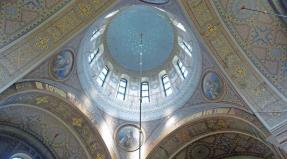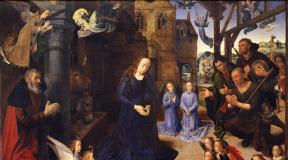Church singing choir of the Sretensky monastery. Chorus from god
The choir has existed in the Sretensky Monastery since its foundation in 1397. Having exchanged for the seventh hundred years, the choir was silent for exactly 70 years under Soviet rule. With the revival of monastic life in the ancient monastery under the arches of its only surviving temple - in honor of the Meeting Vladimir icon Mother of God - in 1993 choral singing sounded again.
Archimandrite Matthew (Mormyl)
(1938-2009)
“If not the founding father, then the forefather-grandfather of the modern, world-famous choir Sretensky monastery can be considered Archimandrite Matthew (Mormyl) - the main regent of the Trinity-Sergius Lavra. He also taught the one who, on the instructions of the father of the governor, assembled the first composition of the choir of the revived monastery - now the Archbishop of Vereya, and then still hegumen Ambrose (Ermakov).
Archbishop Ambrose (Ermakov) Nikon Stepanovich Zhila, a graduate of the Russian Academy of Music named after M.V., grew up in the choir of Father Matthew on the Lavra kliros since childhood and since 2005 has become the permanent artistic director and choir director. Gnessin, Honored Artist of Russia.
"The most terrible thing," the choir director Nikon Stepanovich is convinced, "is to sing without a soul."
Initially, the choir was formed from the monastery's brethren and parishioners, more or less capable of vocals, pupils of the Sretensky Theological Seminary and Moscow Theological Schools - that is, from those who are primarily rooted in the liturgical life of the Church. This principle is still important today. "To create beauty, one must be a pure soul", - are given on official page choir in social networks words of the classical composer M.I. Glinka. "The most terrible thing," the choir director Nikon Stepanovich is convinced, "is to sing without a soul."
Praising the Lord
The choir invariably sings at all the festive services of the Sretensky monastery, be it for the patronal, twelve or any other church celebrations. At least twice a week, choristers sing in the choir: during the all-night vigil on Saturday evening and Divine Liturgy on Sunday morning. “Divine services are the only thing that can truly save a person from the routine that weighs on us,” says Nikon Stepanovich, who grew up in the family of a priest and a singing mother.
|
Chorus in ancient temple Sretensky monastery |
On the rest of the days, the seminary and folk choir sing at services in the monastery, in some cases the texts of the service are distributed to everyone in the church and the general singing is blessed.
Since 2005, the choir under the direction of Nikon Zhila takes part in the main patriarchal services in the Cathedral of Christ the Savior and in the cathedrals of the Moscow Kremlin. Accompanies the Primate on missionary, in particular foreign, trips. Sings at important church events, including the consecration of new or rebuilt churches.
Thus, the choir of the Sretensky Monastery sang at the joint consecration of His Holiness Patriarch Alexy II and the First Hierarch of Russia Orthodox Church Abroad by Metropolitan Laurus in 2007, the temple complex at the Butovo training ground. In the same year he gave a concert in honor of the opening of the first Russian church - the Great Martyr Catherine - in Rome (Italy). In 2008 he accompanied with singing the consecration of the cathedral in the Iversky Monastery on Valdai. The following year, 2009 - the consecration of the Church of Saints Constantine and Helena in Istanbul (Turkey).
|
Choir in the new church of the Sretensky Monastery |
One of the most important moments in the creative biography of the collective, as, indeed, in the history of the Sretenskaya monastery, was, of course, the consecration of the new monastery church of the Resurrection of Christ and the New Martyrs and Confessors of the Russian Church on Lubyanka in the year of the 100th anniversary of the tragic events of the Russian revolution.
Through a song to the souls of men
The renovated choir under the direction of Nikon Zhila, in which he invited many gifted soloists, composers, arrangers with a higher musical education, was blessed by the Father Superior to turn to the song heritage of our people, including that created under Soviet rule.
So, in addition to sacred music, Russian, Ukrainian, Cossack songs appeared in the repertoire of the monastery choir (“On the mountain, on the mountain”, “Oh, you, wide steppe”, “Spring will not come for me”, “Love, brothers, love”, “Nich yaka misyatna ”,“ Oh, on the mountains ”), songs of the war years, performed a cappella, romances and waltzes, beloved by all pre-revolutionary and Soviet times, in unique choral arrangements.
Vladyka Tikhon (Shevkunov) once wrote the article "The Soviet Song as a Sublimation of Prayer." “During the period when orthodox faith was persecuted and forcibly eradicated from the memory of the people, amazing songs were created, which with something, albeit very remotely, but replaced in the souls of people unknown prayer states, "Nikon Stepanovich agrees with him.
Seriously and not so much
In individual programs of the choir, when the songs are announced, the historical context of their creation is reconstructed.
“The feat of the musicians of the Mokshan Infantry Regiment in the Russo-Japanese War remains unfading,” Nikon Zhila announced, for example, the waltz “Mokshan Regiment on the Hills of Manchuria”. - In February 1905, the Mokshan Infantry Regiment in the hardest battles was surrounded. And when the forces of the defenders were running out and they ran out of ammunition, a regimental band began to play right under the bullets in the line of fire - performing military marches one after another, encouraging the soldiers.
Ilya Alekseevich Shatrov The orchestra was conducted by Kapellmeister Ilya Alekseevich Shatrov. The Japanese wavered. The regiment managed to break through the encirclement. But out of 60 people in the orchestra, only 7 survived [from the battle]. They were all awarded with St. George's crosses. In the summer of 1906, Ilya Shatrov, returning to the regiment's location, created the first version of a waltz dedicated to his dead comrades. "
The audience will find many discoveries at the concerts of the Sretensky Monastery Choir. What united the Russian people even during the bloody civil war of the beginning of the 20th century? .. "Both the Reds and the Whites," Nikon Stepanovich prefaces the performance of the next piece, "they loved the same songs." Among them is the well-known romance "White acacia, fragrant bunches ..." - the choir of the Sretensky Monastery performs its original text. The choristers have also reconstructed the words of many other well-known Soviet transcriptions, but in fact, still pre-revolutionary "hits".
Wolfgang Amadeus Mozart The choir of the Sretensky Monastery is sung by the choir of the Sretensky Monastery and hits of our days, for example, "Horse" ("I will go out into the field with a horse at night ...") by Igor Matvienko - for the first time, by the way, performed on the Russian stage in the year of the revival of the Sretensky Monastery. The choir under the leadership of Nikon Zhily, as he himself notes, is also hooligan songs in a good way - they are close to youth in their energy. And the emotional contact achieved in this way will open them, possibly, the masterpieces of the classics.
"Serious music, like Mozart, Beethoven and others, has an ennobling effect on the soul, often under its influence one wants to cry and pray," admitted Colonel Pavel Plikhankov, who once tuned his soul in the philharmonic halls - now glorified in the face Monks of Optina Elder Barsanuphius. Speaking about the creativity of the Sretensky Monastery choir, listeners have repeatedly testified that their songs "contribute to spiritual cleansing."
Everyone is singing!
“Choral singing unites people, gives them spiritual uplift and a sense of fraternal harmony,” noted the composer and choirmaster Georgy Alexandrovich Struve.
Choral singing unites people, gives them the spirit and a sense of brotherly agreement
At the concerts of the Sretensky Monastery choir, the whole audience begins to sing. Here one involuntarily recalls how Father Matthew (Mormyl) admired the extraordinary chanting of the church - when in the church, in a single burst of communion, everyone can sing at the service. At the climax of the choir's performances, Nikon Stepanovich turns to the audience and conducts everyone (the choristers can begin to leave the stage, as it were). For the singing audience, which also cheerfully reacts to the behavior of the choristers, these are the states when those sitting in neighboring chairs can no longer have any claims, envy, hatred or resentment towards each other.
|
Archimandrite Matthew conducts the choir |
Preaching music
Coming out of the walls of the monastery, the choir of the Sretensky Monastery brings people what they then come to the church for.
Those who came to listen to the choir say: "After your concert, I wanted to go to the service as well."
“After your concert, I wanted to go to the divine service where you sing. After all, if here, in a secular hall, you experience such an upsurge of spirituality, what will it be like within the church walls! " - George Sutten, a listener of one of the concerts in America, once admitted. "Yes, after the performances of the choir, many people - both Russians and Americans - come up completely amazed and ask: where is the Orthodox church, how to learn something about this culture and that spirituality that these young people are carrying from the stage?" - confirms, more than once observing such a reaction both abroad and in Russia, Vladyka Tikhon (Shevkunov).
Barrymore Shearer, a critic of one of the largest American publications, The Wall Street Journal, noted a special effect at the concerts of the Sretensky Monastery choir - the effect of being in the church. “It was easy to believe in the Avery Fisher Hall, whose matte walls seemed to be lit up with the faces of icons during the concert! - he wrote. “So great was the associative power of the sounds produced by the choristers.”
"Cultural special forces" of Russia
In 2007, the choir undertook a worldwide round the world tour dedicated to the reunification of the ROCOR with the Russian Orthodox Church. The choir performed in New York, Washington, Boston, Toronto, Melbourne, Sydney, Berlin, London; in 2008 the choir participated in the Days of Russia in Latin America: performed in San Jose, Havana, Rio de Janeiro, Sao Paulo, Buenos Aires, Asuncion. And somehow after the performance of the choir, deeply moved by what had been listened to, one of the emigrants, already an elderly man, approached the choristers with the words: "Russia has come to us."
The Western press called the choir of the Sretensky Monastery "an elite art special forces". ("Monastery Choir: A Special Force" was the headline of a long article in the Washington Post).
The Artistic Special Forces of Russia has already visited more than 45 countries of the world on four continents. Has performed in most of the world's most famous halls: Carnegie Hall, Lincoln Center, the Library of Congress, and the Cathedral Notre dame de paris (Notre Dame de Paris), and the papal residence in the Vatican, and the UNESCO Hall - where they were preceded by all the most famous stars of the world. “We didn’t sing only in Africa and Antarctica,” laughs Nikon Stepanovich.
Sometimes the choir can perform spontaneously. So, on the Great Wall of China, to the amazement of those who also happened to be there, they sang "Amur Waves". Or they can surprise the audience by performing, for example, in the US Library of Congress, an African American spirituals “Go Down Moses” (“Let My People Go”), which is not listed in the concert programs, whose words are written on a biblical story.
Now the choir has its own talented composers and arrangers: Fyodor Stepanov (also acting director of the collective), Alexander Amerkhanov, Dmitry Lazarev. First-class soloists: Mikhail Miller, Mikhail Turkin, Ivan Leonov, Ivan Skrylnikov, Vladislav Chizhov, Nikita Volkov, Vadim Zaripov, Ilya Tatakov.
It was the choir of the Sretensky Monastery that was entrusted with the performance of the anthem Russian Federation at the opening ceremony of the 2014 Winter Olympics in Sochi.
The high mission of the choir of the Sretensky Monastery was repeatedly spoken by numerous fans of the collective, including the most famous persons of modern religious, cultural and political life, including the first hierarchs and heads of state.
Sretensky Monastery Choir website: http://bestchoir.ru.
|
Archimandrite Tikhon (Shevkunov) with the choir of the Sretensky monastery |
Sretensky Choir is an amazing bridge where the past meets the future,
where the connection of times is clearly felt.
Sergey Chesnokov
THE HISTORY OF THE CHORUS OF THE SRETENSKY MONASTERY
How many centuries the Sretensky Monastery stood, so many choirs existed under it, which first became widely known in the 17th century, when the singing monasteries were accompanied by solemn city-wide religious processions... And at the end of 1925 the Sretensky monastery was closed - along with it the choir was gone.
|
Moscow Sretensky monastery Sretensky Monastery was founded in 1397 in memory of the miracle described in the chronicles and occurred in 1395, when Tamerlane, who had ruined Elets, turned his hordes to Moscow. Having learned about this, the Moscow Primate Cyprian blessed the greatest shrine of the Russian land, the Vladimir Icon of the Mother of God, to be transferred from Vladimir to Moscow. For ten days, in a grandiose procession, they carried her to Moscow, where in the meantime the churches were not closed: the people of God prayed day and night for deliverance from the trouble. With hope intercession Holy Mother of God the residents of Moscow met her holy image. And a miracle happened - Tamerlane suddenly changed his mind, and retreating from the almost defenseless city, he went away. The chronicles tell that, having fallen asleep in the tent, he saw the formidable appearance of the Majestic Wife, who commanded him to leave the Moscow borders. In memory of the deliverance from the enemy, on the very place where Muscovites with prayers met the miraculous image of the Most Holy Theotokos ("meeting" in Old Slavonic - "meeting") and the Sretensky Monastery was founded. |
The choir of the monastery revived in 1994 began to acquire its current features about 10 years ago. In 2005, with the blessing of Archimandrite Tikhon (Shevkunov), the choir was headed by its current choir director - Nikon Stepanovich Zhila, a graduate of the Russian Academy of Music. Gnesins, the son of a priest, who sang in the choirs of the Trinity-Sergius Lavra since childhood. Soon, simultaneously with the services, the Sretensky Choir began recording albums and active concert activities.
The choir is based on students of the Sretensky Seminary, as well as graduates of the Moscow Theological Seminary and the Academy. An equally important part of the collective are vocalists from the Moscow Academy of Choral Art, the Moscow Conservatory and the V.I. Gnesins.
Each of the 30 choristers is a real find for the creative team. The choir also includes its own talented composers and arrangers: Fyodor Stepanov, Alexander Amerkhanov, Andrey Poltorukhin, Roman Maslennikov. First-class soloists: Dmitry Beloselsky, Mikhail Miller, Mikhail Turkin, Ivan Skrylnikov, Pyotr Gudkov, Alexey Tatarintsev. Critics often put Dmitry Beloselsky above some other world-famous Russian performers, but despite all their merits, the choir members are an obedient instrument in the hands of the choir director Nikon Stepanovich Zhila, who transforms the consonance of voices into a living organ.
In addition to regular services in the Sretensky monastery, the Sretensky choir sings at especially solemn patriarchal services in the Moscow Kremlin, participates in international music competitions and missionary trips of the Russian Orthodox Church.
|
Choir participation in the life of the Russian Orthodox Church: Consecration of the Church of the New Martyrs and Confessors of Russia at the Butovo training ground by Patriarch Alexy and Metropolitan Laurus, 2007 Visit of His Holiness Patriarch Alexy to the Vologda and Veliky Ustyug diocese, 2007 Concert dedicated to the 90th anniversary of the restoration of the Patriarchal ministry in the Russian Orthodox Church, 2007 Concert in honor of the opening of the first orthodox church (Great Martyr Catherine) in Rome, 2007 Consecration of the Cathedral in the Iversky Monastery on Valdai, 2008 Consecration of the Church of Saints Constantine and Helena in Istanbul, 2009 Concert in the building of the church of St. Irene for Holy Patriarchs Ecumenical Bartholomew and Kirill of Moscow and All Russia, 2009 Overseas Mission Trips: In 2005 the choir took part in the reburial of the remains of General A. Denikin and the philosopher I. Ilyin and accompanied the funeral services in Paris and Moscow. In 2006 the choir gave a concert for the President of Serbia in Belgrade and in the Auditorium of the papal residence in the Vatican. In the same year, the choir performed with triumph in Paris - a prayer service at Notre Dame Cathedral (Notre Dame de Paris) and a concert at UNESCO. In 2007, the choir made a world tour around the world dedicated to the unification of the Russian Orthodox Church. Performances took place at the best concert venues in New York, Washington, Boston, Toronto, Melbourne, Sydney, Berlin, London. In 2008, as part of the mission of the Russian Orthodox Church, the choir of the Sretensky Monastery participated in the Days of Russia in Latin America and performed with great success in Costa Rica, Havana, Rio de Janeiro, Sao Paulo, Buenos Aires, Ansuncion. |
“The first task of the choir is to participate in divine services. Twice a week the collective sings in full force in the church, - N. Zhila said in an interview with "Rossiyskaya Gazeta". - But there is one more direction that is close to us. This is a Russian song of the 20th century. During this period, when the Orthodox faith was persecuted and forcibly expelled from the memory of the people, amazing songs were created, which with something, albeit very distantly, but replaced in the souls of people unknown prayer states. "
|
Secular performances in Russia: For the first time the program “Masterpieces of Russian Choral Heritage” was presented to the general public in Kuzbass in 2005 and 2006. She was awarded with medals "For Faith and Goodness" and "For Service to Kuzbass", which were presented to the choir director by the governor of the Kemerovo region. A.G. Tuleyev. In 2006-2007. the choir took part in divine services and gave concerts in the Far East and Siberia, performed in joint concerts with the Kuban Cossack Choir in (2006, 2007) in Moscow. The choir performs in Moscow in the best concert halls - in the Kremlin Palace of Congresses, the Great Hall of the Conservatory, the Column Hall of the House of Unions. The choir took part in a concert as part of the Christmas Readings, at the Palaces of St. Petersburg festival in 2006, in a concert at the St. Petersburg Philharmonic in 2007. It has become a tradition for the band to perform annually at the Easter Festival. |
The choir's repertoire, in addition to sacred music, contains the best works of the song tradition of Russia - Russian, Ukrainian and Cossack songs ("On the mountain, on the mountain", "Oh, you are a wide steppe", "Spring will not come for me", "Lyubo, brothers , lyubo "," Nich yaka mil ... "," Oh, on the mountains "). Songs of the war years, such as "Enemies burned their native hut", "Eh, roads" or the waltz of the early twentieth century "On the hills of Manchuria" sound unique - the Sretensky choir performs their acapella. Popular and beloved romances "White Acacia Fragrant Bunches", "Misty Morning" in choral arrangement do not leave indifferent either experts or music lovers both in Russia and abroad. According to the conductor of the San Francisco Opera Orchestra, professional singer Thomas Bussé, F. Stepanov's choral arrangement of the famous romance by F. Abt to the verses by Ivan Turgenev “Misty Morning” allows the choir “to show what a tenor with the lightest pianissimo on high notes is capable of. Even professional American choirs have to resort to falsetto on such high notes, but the Russians have enough technique to stretch them. "
The choir at the Moscow Sretensky Monastery arose simultaneously with the founding of the monastery in 1397 and has existed for over 600 years. The choir had a break only during the years of persecution of the church during the Soviet period. In 2005, it was headed by Nikon Zhila, a graduate of the Gnessin Russian Academy of Music, the son of a priest, who sang in the church choir of the Trinity-Sergius Lavra since childhood. The current composition of the choir includes seminarians, students of the Sretensky Seminary, graduates of the Moscow Theological Seminary and Academy, as well as vocalists from the Academy of Choral Art, the Moscow Conservatory and the Gnessin Academy. In addition to regular services in the Sretensky monastery, the choir sings at solemn patriarchal services in the Moscow Kremlin, participates in missionary trips and significant events in the life of the Russian Orthodox Church. A participant in international competitions and music festivals, the choir is actively touring: with the program "Masterpieces of Russian Choral Singing", it has traveled to the United States, Canada, Australia, Switzerland, Germany, England and France. The choir's discography includes albums of sacred music, recordings of Russian folk, Cossack songs, pre-revolutionary and Soviet urban romances.
The choir includes students of the Sretensky Seminary, graduates of the Moscow Theological Seminary and the Academy, the Academy of Choral Art, the Moscow Conservatory and the Gnesins Russian Academy of Music.
In addition to regular services in the Sretenskaya monastery, the choir participates in especially solemn patriarchal services in the Moscow Kremlin, missionary trips of representatives of the Russian Orthodox Church, conducts active concert and tour activities, and records on CDs. The ensemble took part in a concert in honor of the opening of the first Orthodox church in Rome, consecration of the cathedral in the Iversky Monastery on Valdai and the Church of Saints Constantine and Helena in Istanbul, performed in the Auditorium hall of the papal residence in the Vatican, the Paris headquarters of UNESCO and Notre Dame Cathedral ... In 2007, the choir undertook a large-scale tour dedicated to the unification of the Russian Orthodox Church, concerts of which took place on the best stages in New York, Washington, Boston, Toronto, Melbourne, Sydney, Berlin and London. As part of the mission of the Russian Orthodox Church, he took part in the Days of Russia in Latin America (concerts in Costa Rica, Havana, Rio de Janeiro, Sao Paulo, Buenos Aires and Asuncion).
In the repertoire of the collective, in addition to sacred music, the best examples of the song tradition of Russia - Russian, Ukrainian and Cossack songs, songs of the war years, famous romances that artists perform in unique choral arrangements, leaving indifferent neither experts nor music lovers in Russia and abroad ...
How many centuries the Sretensky Monastery stood, so many choirs existed under it, first becoming widely known in the 17th century, when the singing cloisters were accompanied by solemn city processions of the cross. And at the end of 1925 the Sretensky monastery was closed - along with it the choir was gone. The choir of the monastery revived in 1994 began to acquire its current features about 10 years ago.
Show in full
In 2005, with the blessing of Bishop Tikhon (Shevkunov), the choir was headed by its current choir director - Nikon Stepanovich Zhila. Soon, simultaneously with the services, the Sretensky Choir began recording albums and active concert activities. The choir is based on students of the Sretensky Seminary, as well as graduates of the Moscow Theological Seminary and the Academy. An equally important part of the collective are vocalists from the Moscow Academy of Choral Art, the Moscow Conservatory and the V.I. Gnesins.
In addition to regular services in the Sretensky monastery, the Sretensky choir sings at especially solemn patriarchal services in the Moscow Kremlin, participates in international music competitions and missionary trips of the Russian Orthodox Church. songs (“On a mountain, on a mountain”, “Oh, you are a wide steppe”, “Spring will not come for me”, “Love, brothers, love”, “Nich yaka a million ...”, “Oh, on the mountains”). Songs of the war years, such as "Enemies burned their native hut", "Eh, roads" or the waltz of the early 20th century "On the hills of Manchuria", sound unique - the Sretensky choir performs their acapella. Popular and beloved romances "White acacia fragrant bunches", "Misty morning" in a choral arrangement do not leave indifferent either experts or music lovers both in Russia and abroad.
IN last years the choir of the Sretensky Monastery has recorded several music albums with sacred chants and the best songs of the classical and folk repertoire.
Live willow organ. The choir of the Sretensky Monastery is often compared in sound to this magnificent instrument. Whatever the group performs: church chants, Russian folk songs or the anthem of Russia.
One of the oldest monasteries in the capital.Built on the site of the meeting (meeting) of the miraculous Vladimir Icon of the Mother of God. According to legend, this image saved Moscow from Tamerlane. Since then, chants have sounded in the monastery - day and night the monks prayed for peace in Russia.
The convent's age is the monastic choir.The oldest singing collective in Russia - with a six-hundred-year history. Sretensky chanters accompanied the solemn city processions of the cross. In 1925, the monastery was closed - and the choir was gone. It was only 70 years later that the traditions of spiritual chanting were revived.
"God with us". Music by Pavel Chesnokov. Arranged by Andrey Poltorukhin. Soloist Alexey Tatarintsev.
The choir of a monastery does not mean a choir of monks. There are five collectives in the monastery: seminarians, a brotherhood choir, parishioners, a female choir and a concert one. All sing at the divine services, and "representative" performances are the lot of thirty choristers - professional musicians with a spiritual education.
"I believe." Music by Alexander Grechaninov. Arranged by Alexander Amerkhanov. Soloist Dmitry Beloselsky.
Amazing a "cappella. “30 people with a voice palette that replaces a whole symphony orchestra. Two bass-octavists, a luxury that only Russian choral groups are famous for. And every singer is a real find, ”says choir director Nikon Zhila.
"I go out alone on the road". Music by Elizaveta Shashina. Poems by Mikhail Lermontov.
"Special braces". The harmony of the sound adds attention to the spiritual component of the works. And here the status of the monastery choir and the fact that its participants are churchly people helps. Musicians make friends with families, baptize children and celebrate holidays.
"Ah, it is not yet evening". Cossack folk song.
Secular premiere. The Sretensky choir performed outside the church for the first time in Kuzbass 10 years ago. Since then, the best concert venues have been mastered: the Kremlin Palace and the Conservatory, the Christmas and Easter festivals. This does not negate the compulsory participation in worship.

Missionary tour.New York, Washington, London, Toronto, Sydney, Berlin. Prayer service under the arches of Notre Dame Cathedral and a concert at UNESCO. Sretensky Choir made a world tour in honor of the unification of the Russian Orthodox Church.
“Sretensky Choir is a performing arts phenomenon. The unique voices of its soloists make this choir one of the world's finest ensembles. Their extraordinarily creative and original interpretations church chants and folk songs allow their listeners to make an exciting journey to the very origins of Russian culture "
Minister of Culture of Russia Vladimir Medinsky
Olympic achievements and ... new sports traditions.The performance of the Russian anthem in the "Sochi version" made a splash. And gained followers. The Vityaz hockey club near Moscow decided to open each home match with a hymn performed by the Sretensky choir.
"Heaven and Earth".Choir program name and brief excursion into the repertoire. The musical group has eight albums. Spiritual chants, folk songs, romances. The works are famous and unique. As a Greek chant based on the ancient Byzantine system of modes.
Polyushko-Pole. Music by Lev Knipper, poems by Viktor Gusev. Arranged by Dmitry Lazarev.
New page. In 2017, a church of the New Martyrs and Confessors of Russia on Blood will be built in the monastery. The temple is large - for two thousand parishioners ... and listeners of the choir. The unique sound of the band in their home monastery will be complemented by cathedral acoustics.

A sketch of the project of the Church of the New Martyrs and Confessors of Russia on the Blood is planned to be erected in the Sretensky Monastery and consecrated in February 2017 © Photo: Pravoslavie.ru
Archimandrite Tikhon Shevkunov's documentary "The Russians"



















